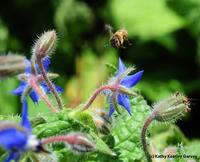Borage
Borage, Borago officinalis, is native to the Mediterranean region. It is also known as starflower, bee bush, bee bread, and tailwort. It is typically grown for its bright blue star-shaped flowers. The flowers and leaves have a cucumber-like flavor, and can be used in salads or as dessert or beverage garnishes. Pollinators are very attracted to the bright blue flowers.
How to grow
- Type: Summer annual
- Light: Full sun to partial shade
- Soil: Well drained; will tolerate poor soil
- Water: Dry to medium moisture; will tolerate some drought
- Size: 1–3' high x 9–18" wide
When to plant/propagate
- From seed: Sow seeds in early spring
- Propagation: Will readily self-seed once established
Harvesting:
- Harvest leaves when young and tender. They quickly become coarse and hairy, giving them an unpleasant texture for eating.
- Harvest flowers as needed.
- Both leaves nor flowers lose their flavor when dried, so are best used fresh or frozen. Ice cubes with borage flowers make a pretty garnish for beverages.
Common pests & diseases
Indoors: Borage can be grown as an indoor plant with 5–6 hours of bright light from a sunny window, or 12–16 hours of supplemental light provided by cool white fluorescent or LED lamps. Borage has a tap root, so plant in a deep container.
Other: Borage is a historic medicinal herb and contains small amounts of pyrrolizidine alkaloids, which may cause liver issues when the plant is consumed as a major part of the diet
More information
- Borago officinalis, Missouri Botanical Garden
- Borago officinalis, North Carolina State University Cooperative Extension







